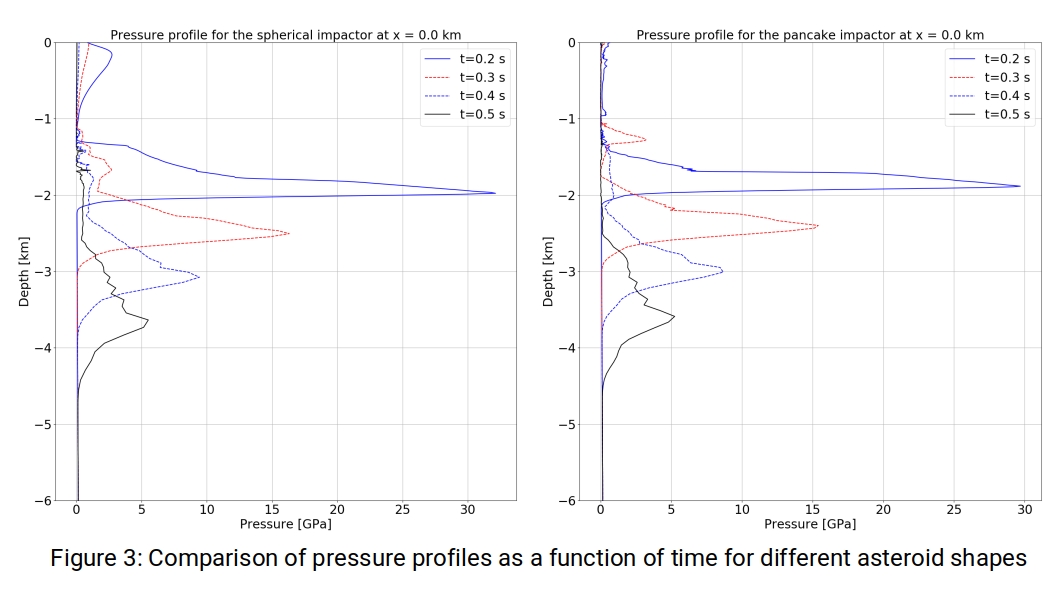Numerical modeling of the Lockne impact crater with emphasis on the role of asteroid shape
- 1Geosciences, Auburn University, United States of America
- 2Centro de Astrobiologia, Instituto Nacional de Tecnica Aeroespacial
- 3Department of Earth Sciences, University of Gothenburg
- 4Aerospace Engineering, Auburn University, United States of America (vinagr@auburn.edu)
Introduction
The Lockne crater, located in central Sweden, is a marine-target structure formed approximately 470 million years ago in an epicontinental sea [1][2]. The water depth at the time of the impact is estimated to be around 500 meters [3]. The nearly horizontal target rocks were comprised of, from top to bottom, ~50m of limestone, ~30m of dark, organic rich, shale, and Proterozoic crystalline basement [1]. The structure consists of a 7.5 km wide nested crater, in the basement, surrounded by a 14 km wide outer crater, where most of the sediment material was excavated [2]. Core drilling in the inner nested crater revealed crater-fill breccias composed mostly by sedimentary material, interfingered with crystalline breccia lens (Tandsbyn breccia) and resurge deposits (Lockne breccia and Loftarsone). The Lockne crater has been hypothesized to have been formed by a rubble-pile “pancake” shaped impactor that formed the Lockne-Målingen crater doublet [4]. The objective of this study is to understand, through numerical simulations, the Lockne crater formation based on different asteroid parameters such as dimensions, density, shape, and velocity.
Methodology
The formation of Lockne crater is being simulated by iSALE, an extension of the SALE hydrocode developed to model impact crater formation [5,6,7,8]. Current study focuses on iSALE-2D simulations with an axisymmetric approximation of the original impact problem. The model comprises an asteroid traveling at 20km/s impacting a three-layer target: (1) crystalline basement, (2) ~80 meters of limestone, and (3) 500 m of sea water. Two cases of asteroid shape were considered: a spherical asteroid of diameter 630m and a ‘pancake’ ellipsoidal asteroid with an aspect ratio of 8:1 between the horizontal and vertical axis. In both cases, asteroid damage was set to 1 representing a less cohesive and more fragmented impactor. To ensure comparison across the two cases, the asteroids had the same net mass (2.9 x10^11 kg) and kinetic energy (5.9 x10^19 J).
Results
The spherical asteroid scenario produces a crater of approximately 8 km in diameter and 2 km in depth (Figure 1), whereas the ellipsoid impactor produced a 12km wide crater with 3.5 km in depth. The crater in the ellipsoidal case has not stabilized yet, and the simulation is still running (Figure 2). As expected, the maximum pressure for the spherical impactor at 0.2 seconds is higher (at approximately 33 GPa) than that produced by the pancake impactor (at approximately 28 GPa). This is presented in Figure 3. Despite the differences in dimensions, the collapse of the ejecta curtain, overturn of rim flap, and subsequent outward tsunami formation occurs in similar timesteps in both cratering processes, at about 35-40 seconds. The spherical impactor scenario produces higher wave amplitudes and at about 50 seconds the sea water starts to return into the crater bowl. In the pancake-shaped impactor scenario, the waves amplitude are lower and a greater mass of water is displaced to longer distances in an outward direction from the crater (simulation is still running and resurge water is not visible yet). This is attributed to the pancake shape of the asteroid impacting the target over a wider area. In both scenarios, the proximal ejecta is composed sedimentary material interfingered with large blocks of the crystalline basement.

To systematically quantify the effect of asteroid shape and acquire more realistic impact conditions, new simulations are currently running with spherical and ellipsoidal impactors of varying aspect ratio (2:1, 3:1 and 4:1) at an impact speed of 13 km/s and 18 km/s. For a given impact speed, the total asteroid mass (and kinetic energy) is kept the same while the aspect ratio is varied. Additionally, for each combination of asteroid shape and impact speed, two different cases are considered: intact asteroid (with damage set to 0) and loosely packed asteroid (with damage set to 1).
References
[1] Lindström et al. (2005) Impact Studies, Springer 357-388 [2] Ormö et al. (2007) Meteoritics & Planet. Sci. 42, 1929-1943 [3] Ormö et al. (2002) JGR, 107, 31-39 [4] Sturkell E. and Ormö J., EPSC abstracts 2020, EPSC2020-956. [5] Melosh H.J. et al. (1992) JGR 97, no. E9, 14735-14759. [6] Ivanov B.A. et al. (1997) Int. J. Impact Eng. 20, 411-430. [7] Collins G. et al. (2004) MAPS 39, 217-231. [8] Wunnemann K. et al. (2006) Icarus 180, 514-527.
Acknowledgements: The authors are grateful to the CSIC financial support for international cooperation: I-LINK project LINKA20203 “Development of a combined capacity of numerical and experimental simulation of cosmic impacts with special focus on effects of marine targets”.
How to cite: De Marchi, L., King, D., Ormö, J., Sturkell, E., and Agrawal, V.: Numerical modeling of the Lockne impact crater with emphasis on the role of asteroid shape, European Planetary Science Congress 2021, online, 13–24 Sep 2021, EPSC2021-445, https://doi.org/10.5194/epsc2021-445, 2021.

